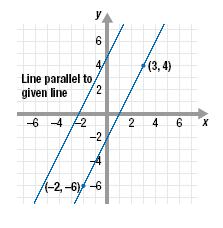Slopes of Parallel Lines
Distinct parallel lines never intersect.
Lines that are parallel (and not vertical) have the same slope.
Example
Find the slope of a line parallel to the line that passes through the points
(3, 4) and (-2, -6).
Solution
| First, find the slope of the line through
the given points.
Let (x1, y1) = (3, 4) and (x2, y2)
= (-2, -6). |
m |
 |
| Substitute the values in the slope formula.
Simplify. |
|

= 2 |
The slope of the line through (3, 4) and (-2, -6) is 2.
A line parallel to the line through (3, 4) and (-2, -6) has the same
slope, 2.

|